Elliptic curve
![]()
This article deals with elliptical curves. For the ellipse as a geometric figure see Ellipse.
In mathematics, elliptic curves are special algebraic curves on which an addition is geometrically defined. This addition is used in cryptography to construct secure encryption methods. However, elliptic curves also play an important role in pure mathematics. Historically, they arose through the parametrisation of elliptic integrals as their inverse functions (elliptic functions).
An elliptic curve is a smooth algebraic curve of order 3 in the projective plane. Elliptic curves are usually represented as curves in the affine plane, but they also have an additional point at infinity.
Elliptic curves over the body of real numbers can be regarded as the set of all (affine) points 
together with a so-called point at infinity (written as 





In general, however, one will not limit oneself to the case of real coefficients and solutions when considering the given equation, but rather consider the case where coefficients and solutions originate from the body of complex numbers. Elliptic curves over the body of rational numbers, over finite bodies and over p-adic bodies were also studied in detail. The theory of elliptic curves therefore connects very different subfields of mathematics. The investigation of elliptic curves over the rational numbers or finite bodies is the subject of number theory and a special case of the abelian varieties also considered in higher dimensions. Their investigation over the complex numbers is a classical field of function theory.
Every elliptic curve over the complex numbers can be represented as a complex torus with the help of a lattice in the complex number plane, which already results from the double periodicity of elliptic functions (see Weierstrass elliptic function). Their Riemann surface is topologically a torus and, via the associated division of the complex plane by a lattice, an abelian group. This group structure also carries over to elliptic curves over the rational numbers and to a special kind of addition for points on elliptic curves (see below). In 1994, the mathematician Andrew Wiles proved the modularity theorem, which states that all elliptic curves over the rational numbers are parameterised by modular forms. With the help of this theorem, it was possible to prove Fermat's Great Theorem, a well-known number-theoretical statement that is easy to formulate but difficult to prove.
Practical applications of elliptic curves are found in modern encryption methods (elliptic curve cryptosystem), which use the above-mentioned special addition of points on elliptic curves for the definition of one-way functions. Further applications can be found in the factorisation of natural numbers.
If instead of cubic polynomials those of higher than fourth degree are considered, one obtains hyperelliptic curves (which have higher topological gender).
Solutions of the equation 


History
The theory of elliptic curves first developed in the context of function theory. Elliptic integrals occur in various geometric or physical problems - for example, in determining the arc length of ellipses. Inverse functions could be determined for these integral functions. These meromorphic functions were called elliptic functions because of this context (for their history see there). As will be shown below, by means of elliptic functions one can uniquely assign a torus to any elliptic curve over the body of complex numbers 
Since the end of the 19th century, arithmetic and number-theoretic questions have been at the centre of theory. It could be shown that elliptic curves can be meaningfully defined on general bodies and it was shown - as described before - that an elliptic curve can be interpreted as a commutative group (which goes back to Henri Poincaré).
In the 1990s, Andrew Wiles, following preliminary work by Gerhard Frey and others, was able to prove Fermat's 17th century conjecture by means of the theory of elliptic curves.
Affine and projective plane
The two-dimensional space of the 
with the equivalence relation

Points from 

The projective plane 
with the hyperplane 


To represent projective cubes in the affine plane, one then identifies for 


In the case of an elliptic curve, the (projective) polynomial equation has exactly one solution with 

Definition


is a smooth projective curve over
of gender 1 with a point
whose coordinates
lie in
is a smooth projective cubic over
with a point
whose coordinates
lie in
is a smooth equation given by a Weierstrass equation
given projective curve with coefficients 
then is 
![F\in K[X,Y,Z]](https://www.alegsaonline.com/image/ab56372317727ba1a9cdf8c85214c3f0a9169e92.svg)


If one takes 
(in long Weierstrass form / Weierstrass normal form) resp. an affine polynomial ![f(x,y)=y^{2}+a_{1}xy+a_{3}y-x^{3}-a_{2}x^{2}-a_{4}x-a_{6}\in K[x,y]](https://www.alegsaonline.com/image/ce11776a13634e4dfd456967cfca11bb0b66facc.svg)



Isomorphic elliptic curves
Definition
Every elliptic curve is ![f(x,y)\in K[x,y]](https://www.alegsaonline.com/image/e9d3ea04e0bb62f4380d8ad0144f89213abef84f.svg)
![F(X,Y,Z)\in K[X,Y,Z]](https://www.alegsaonline.com/image/865630a8ab545e3261e952789612dbc2169f7a01.svg)




with 
Short Weierstrass equation
If an elliptic curve over a body 

then there exists a change of coordinates which transforms this Weierstrass equation into the equation
transformed. This is called a short Weierstrass equation. The elliptic curve defined by this short Weierstrass equation is isomorphic to the original curve. It is therefore often assumed without qualification that an elliptic curve is given from the outset by a short Weierstrass equation.
A further result of the theory of Weierstrass equations is that an equation of the (short Weierstrass) form
describes a smooth curve exactly when the discriminant Δ 

does not disappear. The discriminant is proportional to the product 

Examples
and
are elliptic curves over
, since Δ
and Δ
.
is an elliptic curve over both
and over
since the discriminant Δ
. Over a body with characteristic
on the other hand, Δ
and
singular, i.e. not an elliptic curve.
is
an elliptic curve over any body with characteristic not equal to since Δ
Above the real numbers, the discriminant gives information about the shape of the curve in the affine plane. For Δ 



Diagram of exemplary curves
Group operation
Elliptic curves have the special feature that they are commutative groups with regard to the point-wise addition described in this section. In the first subsection, this addition is illustrated geometrically before it is further formalised in the following sections.
Geometric interpretation
Geometrically, the addition of two points of an elliptic curve can be described as follows: The point at infinity is the neutral element 







In the case of a tangent to the point 









One can show that this "addition" is both commutative and associative, so that it actually satisfies the laws of an abelian group. The Cayley-Bacharach theorem can be used to prove the associative law.
Let be 







The task of finding 

Addition of two different points








Then the addition is given by
and
defined.
The two points 











Doubling a point
For the point duplication (addition of a point to itself) of a point 
Case 1:
. Here
taken from the curve equation (
).
The only difference to the addition of two different points is the calculation of the slope.
Case 2:
Because of 

Calculation rules for the "addition" of points of the curve
Analytical description via the coordinates:
Be
two different points,
the addition of two points and
the neutral element (also called infinity point).
The following rules apply:
Scalar multiplication of a point
The scalar multiplication 
This multiplication can be solved efficiently with the help of an adapted square & multiply method.
For an elliptic curve over the finite body 


Elliptic curves over the complex numbers
If, as usual, the complex numbers are interpreted as elements of the Gaussian number plane, elliptic curves over the complex numbers represent a two-dimensional surface embedded in the four-dimensional 
Complex Tori
Let Γ be 







by gluing opposite sides together.
Reference to plane cubes
The functions that parameterise elliptic curves form a large family and have special properties. Since they are defined on a plane and not just on a number line, they can even be required to have periodicity in two directions simultaneously. These functions are also called p-functions. One uses for them the designation 

If Γ is 

whose image is the non-singular cubic
is. Every non-singular plane cubic is isomorphic to a cubic created in this way.
· 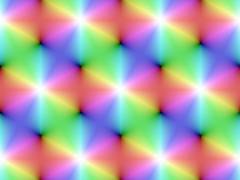
In contrast to the sine or cosine, 
· 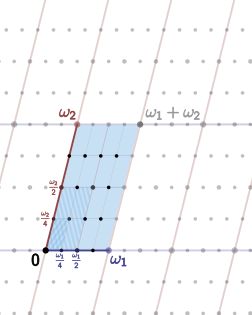
It is only decisive for each 
· 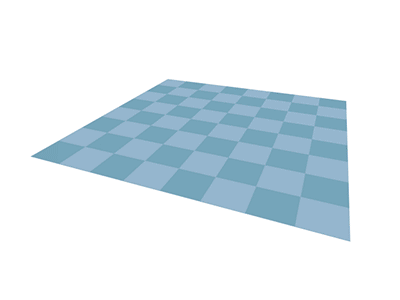
The mesh can be deformed into a donut as follows. Because of periodicity, opposite sides can be glued together since the parameters there provide the same points on the curve. It can be argued that there is a perfect 1:1 relationship between points on the periodic mesh and the elliptic curve, making it legitimate to think of an elliptic curve as a perfect donut surface.
Also analogous to sine and cosine, one finds that the 







In this procedure, care must be taken that the choice of the p-function (and thus the choice of the appropriate period mesh) depends crucially on the numbers 

The elliptic function is defined by its Weierstrass form in a lattice Γ 





Points of finite order in the grid are called torsion points. A torsion point of 
with 




Classification
Two one-dimensional complex tori 










is given (moduli group). Two elements τ 





this space is bijectively mapped by the 



Elliptic curves over the rational numbers
The addition of points of elliptic curves makes it possible to calculate further solutions from simple (guessed) solutions of a cubic equation, which usually have much larger numerators and denominators 
For example, for the elliptic curve defined over 
one finds by guessing the solution 

for points with integer coordinates on elliptic curves over 


The group of rational points 











![{\displaystyle E(K)[N]}](https://www.alegsaonline.com/image/fa57c12bc605b0435aef5339ad957a39b3b1582e.svg)

According to the theorem of Lutz and Nagell (Élisabeth Lutz, Trygve Nagell, mid 1930s), for the torsion points, i.e. the points 








The possible torsion subgroups for elliptic curves over the rational numbers were classified by Barry Mazur in a difficult proof (Mazur's theorem (Elliptic Curves)). According to this, for a point of order 

With the theorem of Lutz and Nagell and that of Mazur one has an algorithm for determining the elements 



- Find
with discriminant D
of the curve.
- Determine the associated
from the equation of the curve and thus have the coordinates of
.
- Calculate
with
(according to Mazur's theorem), if
(using here the notation
for the neutral element), one has a torsion point. If, on the other hand,
has no integer coordinates, it does not belong to the torsion points.
Elliptic curves, according to Mordell's conjecture (Faltings' theorem, they correspond there to the case of the gender 


The theory of elliptic curves over the body of rational numbers is an active field of research in number theory (arithmetic algebraic geometry) with some famous open conjectures such as the conjecture of Birch and Swinnerton-Dyer which makes a statement about the analytic behaviour of the Hasse-Weil 


Elliptic curves over finite bodies
Instead of over the rational numbers, one can also consider elliptic curves over finite bodies. In this case, the plane, or more precisely the projective plane, in which the elliptic curve lies, consists only of finitely many points. Therefore, the elliptic curve itself can also contain only finitely many elements, which can simplify many considerations. For the number 


thus proving an assumption made in Emil Artin's dissertation (1924).
More generally, from the Weil conjectures (a series of conjectures on the Hasse-Weil zeta function, proved in the 1960s and 1970s) for the number 



where α 




Elliptic curves over finite bodies are used, for example, in cryptography (elliptic curve cryptosystem).
The (as yet unproven) conjecture of Birch and Swinnerton-Dyer attempts to obtain statements about certain properties of elliptic curves over the rational numbers by investigating corresponding properties of elliptic curves over finite bodies (so-called "reduced elliptic curves").
Hasse-Weil zeta function and L-function for elliptic curves
the elliptic curve 

with integer coefficients 





The zeta function of an elliptic curve over a finite body is the formal power series
It is a rational function of the form
(This equation defines the coefficient 


The 



with ε 



The product converges for Hasse conjectured (Riemann conjecture for elliptic curves) that the 




Application in cryptography
→ Main article: Elliptic Curve Cryptography
The US foreign intelligence agency NSA recommended in January 2009 that encryption on the internet be switched from RSA to ECC (Elliptic Curve Cryptography) by 2020.
ECC is a public-key cryptosystem (or asymmetric cryptosystem) in which, unlike a symmetric cryptosystem, the communicating parties do not need to know a common secret key. Asymmetric cryptosystems in general work with trapdoor functions, i.e. functions that are easy to calculate but virtually impossible to invert without a secret (the "trapdoor").
Elliptic curve encryption works in principle by assigning the elements of the message to be encrypted (i.e. the individual bits) in some way to the points 



Since the problem of the discrete logarithm in elliptic curves (ECDLP) is significantly more difficult than the calculation of the discrete logarithm in finite bodies or the factorisation of integers, cryptosystems based on elliptic curves - with comparable security - manage with considerably shorter keys than the conventional asymmetric crypto methods, such as the RSA cryptosystem. The currently fastest algorithms are the Babystep-Giantstep algorithm and the Pollard-Rho method, whose runtime is 

Search within the encyclopedia
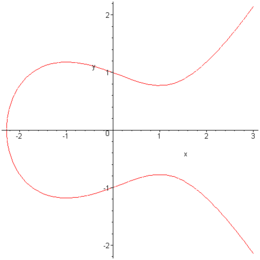

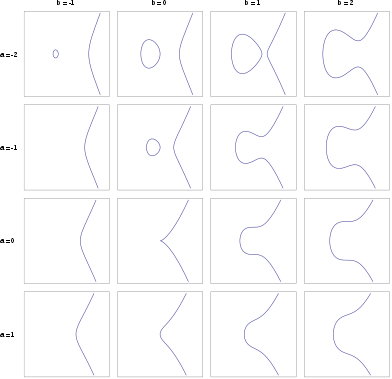


























.svg.png)







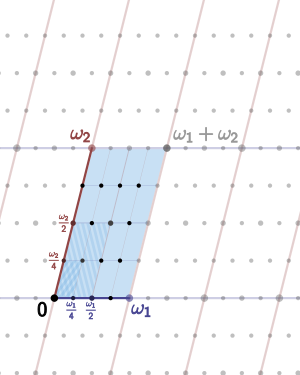




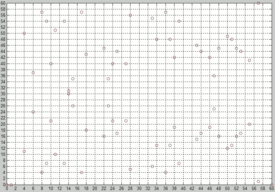


![Z(E({\mathbb {F}}_{p}))=\exp \left(\sum {\mathrm {card}}\left[E({{\mathbb F}}_{{p^{n}}})\right]{\frac {T^{n}}{n}}\right).](https://www.alegsaonline.com/image/11380efd02265f1c8112db20d7526def3732555b.svg)

